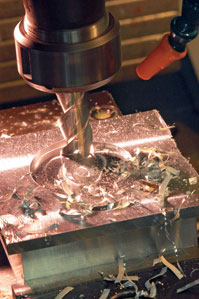
EDUARDO CESARLathe in action: fluid lubricates and prevents wear and tear of partsEDUARDO CESAR
Vital products for machine processes and the re-tooling of parts in manufacturing companies, lubricating oils also pose a risk to human health and the environment. These fluids, which lubricate and reduce the wear and tear in cutting tools, such as lathes, milling machines and drills, result in better surface finishing in the machinery, but if not disposed of properly, become pollutants. They contain an organic material that is an emulsifying agent which makes them susceptible to attack by fungi and bacteria. These are a source of contamination for factory workers and also reduce the useful life of the fluids, speeding up their disposal. It may be possible to solve this problem with a system for disinfecting fluids by using ultraviolet radiation (UV). This was created by researchers from the Abrasion Machine Laboratory at the School of Engineering at Paulista State University (Unesp) in the city of Bauru, inner-state São Paulo.
“The UV rays penetrate the cell wall of the microorganisms in the fluid, reaching the nucleus, where the genetic information is. This absorption causes a rearrangement in the DNA chain, interfering in the capacity of these beings to reproduce. As a result, the irradiated microorganisms become inactive,” explains engineer Eduardo Carlos Bianchi, who is heading up the research, which was helped by the Laboratory of Experimental Immunopathology at Unesp’s School of Sciences in Bauru and by the Instituto Fábrica do Milênio (IFM), as well as researchers Olavo de Arruda, Paulo de Aguiar and Francine Piubeli. To fight this problem, companies have been adding biocides to the fluids, substances that exterminate microorganisms or inhibit their growth. According to Bianchi, one advantage of disinfection by UV is its effect on bacteria and fungi, whereas biocides only affect bacteria.
The technology created at Unesp involves a reservoir of fluid with a lid, to which 20-watt ultraviolet lamps are attached. During the machining process, this oil is driven by a pump to the site of the cut, where it is poured onto the part and the tool. Shortly afterwards, the lubricant returns to the reservoir via a collecting system.
The product can become contaminated in a number of ways, the primary source being either the machine operator himself, through physical contact, droplets of saliva, or perspiration. Furthermore, fungi and bacteria can affect the lubricant when it is poured onto the piece, in the reservoir and during its path over the machine?s surface, or in the tubes on its return to the reservoir. “When the polluted fluid is replaced by a new one, this is quickly contaminated by the remains of the previous fluid,” warns Bianchi. “Although large companies have prior treatment technologies and dispose of pollutants properly, it is well known that small companies take the easiest path, dumping the fluid into the sewage system.” According to Bianchi, this technology is ready to be passed on to the industrial sector, with just a few details pending solution by the partnership between the university and industry.
The Project
Use of ultraviolet radiation in controlling microbial contamination in cutting fluids (nº 04/10848-8); Type Regular Research Awards; Coordinator Eduardo Carlos Bianchi – Unesp; Investment R$ 46,188.10 (FAPESP)

